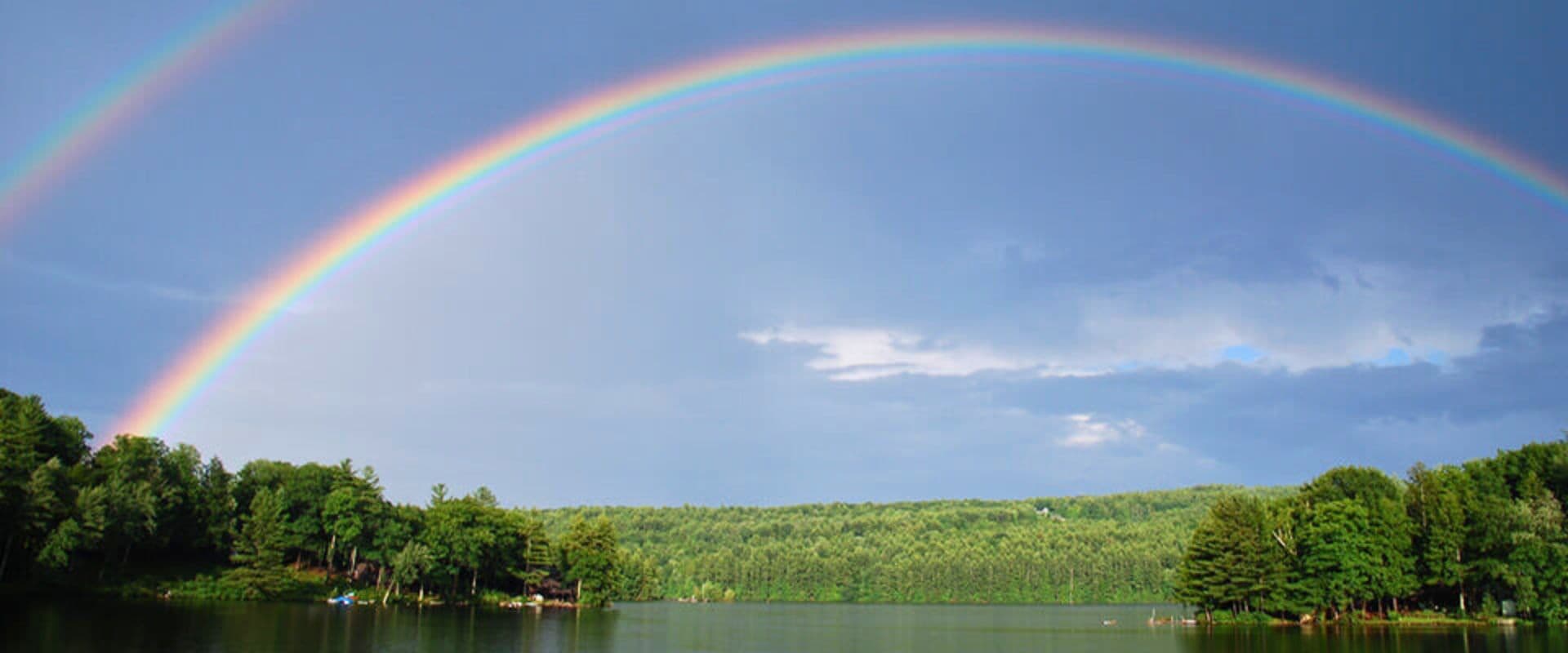
A Short History of Lake Horace
Originally Weare Reservoir (now Lake Horace) was constructed for the Public Service Co. of New Hampshire. This body of water was used to keep Glenn Lake in Goffstown full in the dry summer months which supplied the power for the Gregg’s Falls power plant. This hydro-electric plant was built into the dam itself and has operated very efficiently for years. Our lake covers 268 acres flowing over meadows and woodlands and is fed by the Piscataquog River out of Piscataquog Reservoir at Deering Center, another storage area for Public Service Co. waters. Dudley Brook out of Pleasant Pond in Henniker, Putney Brook from the Craney Hill area in Weare, and the Johnson Brook which flows in just to the right of Lake Shore Village Resort also feed our lake. There are also several other small brooks which meander through farmlands into these streams as well as scores of springs from the meadows under the lake. Deering Reservoir is mostly spring fed too; these many springs are the reason for the purity of the water in Lake Horace.
I remember the construction of the dam, a far cry from the methods of today with modern machinery and the cement trucks which deliver premixed concrete to any construction site. At that time, Italian workers pushed wheelbarrows of heavy concrete along a ramp, dumping them into chutes which carried the mixture into the forms shaping the dam. This ramp was a maze of wooden trestles – barely wide enough for the men to walk pushing a heavy wheelbarrow. As I walked along this walkway with my father sightseeing (at 8 years old), I thought it was awful high!
The largest area of the flowage area was owned by two families, Horace Chase and Benjamin Bartlett. There were several other small owners around the shoreline too. The Chase land was mostly meadows which were hayed for the Chase Farm. The Bartlett land was a 190-acre pasture, partly woodland meadow, about 90 acres now under water and the rest of it incorporated into the now - Lake Shore Village development. The Bartlett land was reached by an old wood road extending through the woods and down a steep hill alongside the Fred Colburn farm. Benjamin Bartlett used oxen to haul the meadow hay up to his barns just over the Deering line from our home. This was used for cattle and a large flock of sheep. The same road is now Colburn Cottage Road and parts of it extend past several of the cottages.
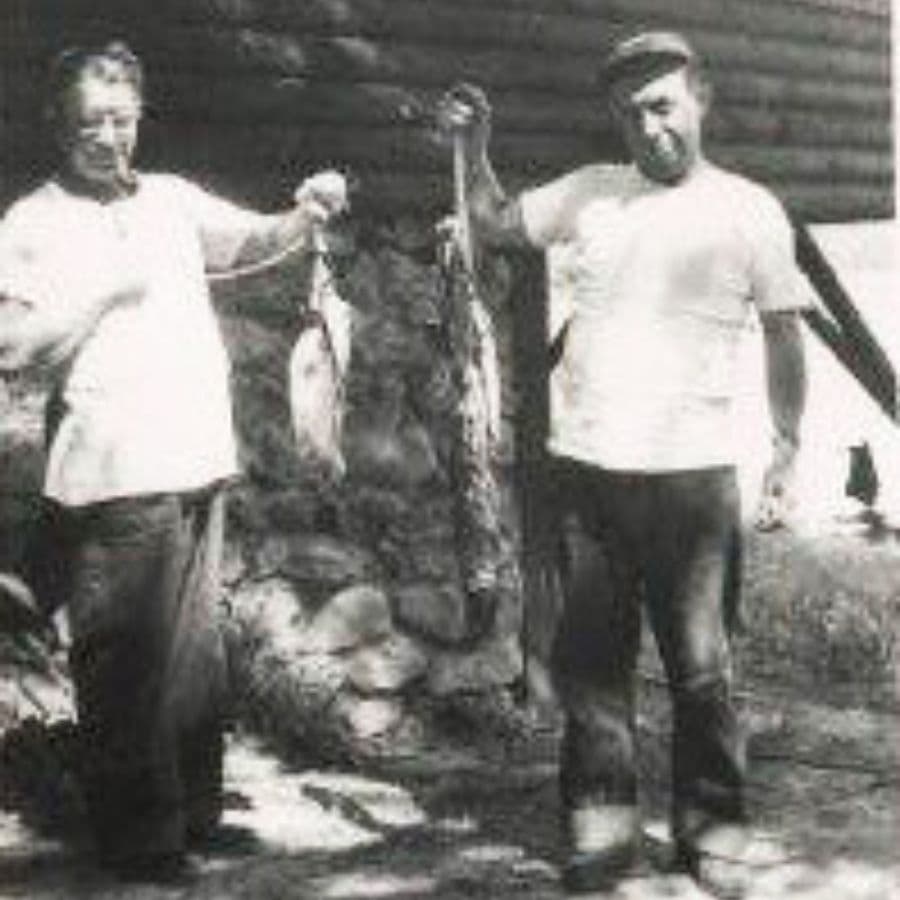
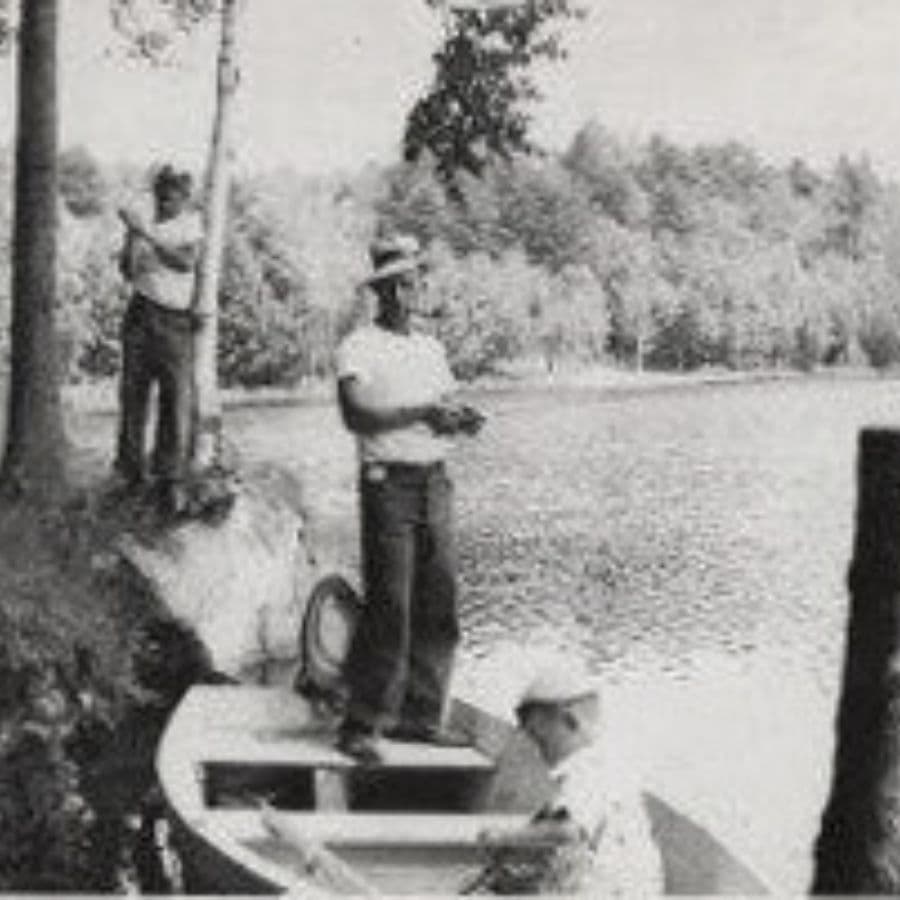
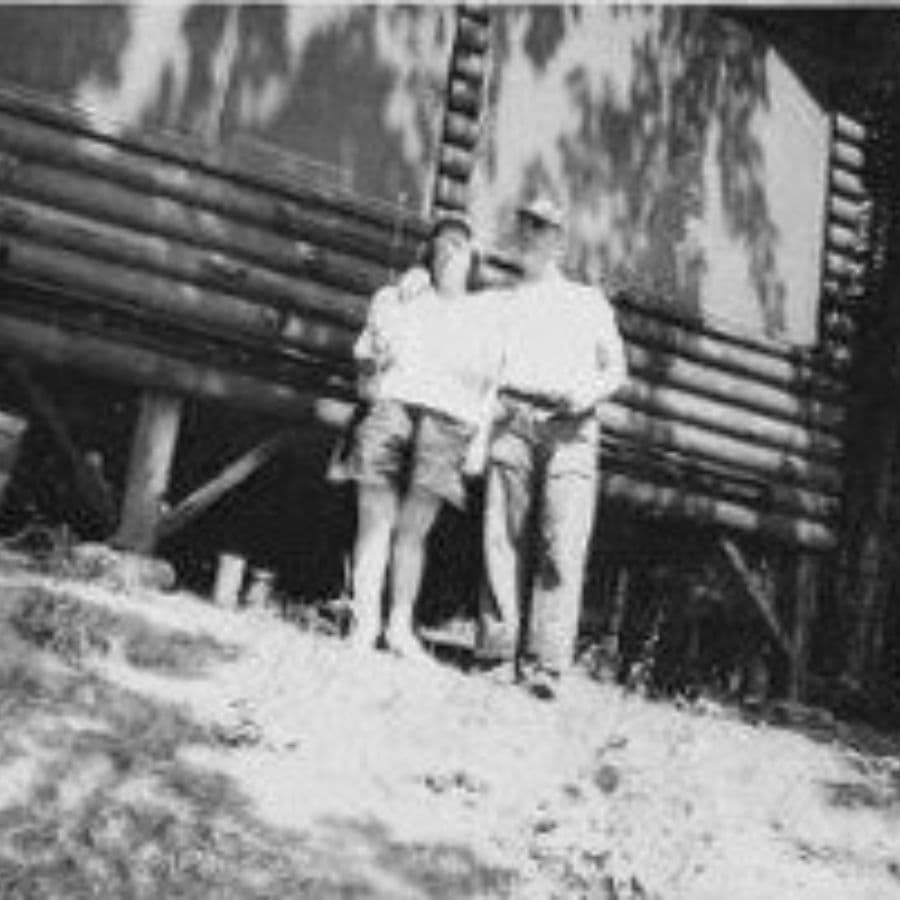
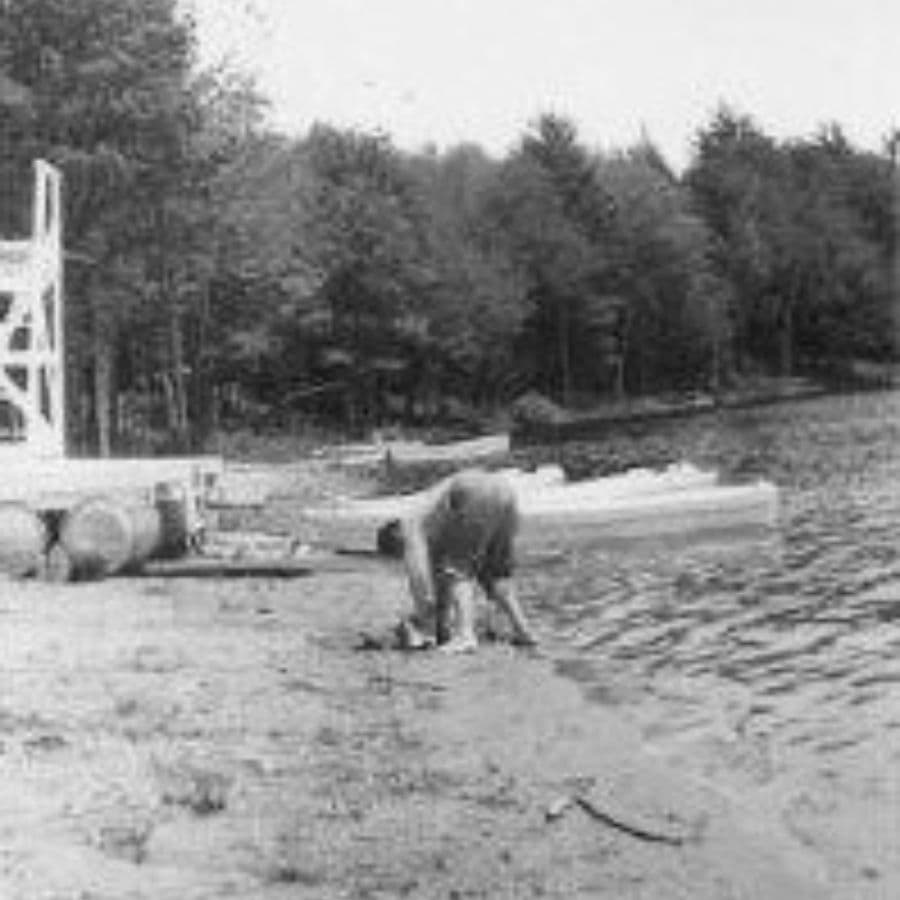
There is an interesting episode about the start of the Weare Reservoir project which was told to me by my father. At that time I was too young to fully appreciate it. In order to approve the building of the dam, an article was placed in the town warrant to be voted on at the March town meeting. This article read as follows: “To see how much money the town will vote to raise toward the construction of a reservoir to be located above the so called “Box Shop Pond” (Drewry Brothers Toy Shop).” It seems that Chase and several of the small owners wished to sell their land while many others, especially the farmers away from the village, were against it. The article required the town to furnish a sizable sum for the road changes and the dam construction. It was voted to spend $10,000 dollars, with Public Service Co. contributing $20,000. Many could see no benefit to the town, they felt Public Service Co. should pay all costs, as they were to benefit the most. Of course, there were several woodworking shops which would be helped a little, as all of this depended on water power to operate. But these small shops had operated for years on the natural flow of the river. The way this bill was passed is interesting. As often happens with argumentative articles at small town meetings, a voice vote was called for and this article was put off until more important ones could be taken care of. This brought this article’s vote late into the evening and many of the opposing farmers had to go home to do their “chores.” Cows had to be milked at regular times. When the vote came up, the article was easily approved, as those who opposed it were not there. We had politicians back in those days too!
This was in 1910 and the dam finished in 1913. The first filling of the lake took several weeks before the water ran over the dam. Back at the time, land could be flowed over without cutting timber or wood, so the water covered small trees and bushes, and reached to a depth of twenty or thirty feet on the larger trees. A year later these trees died and became a maze of standing skeletons. We used to cross over the cove in a boat from what is now our beach, pulling ourselves from tree to tree as there wasn’t room to use oars. Once out of the cove, over the former meadow, it was clear sailing. Towards the upper end of the lake a large barn stood for several years before it crumbled away, the gable end floating, caught between elm trees which grew on either side of the barn doors. This made an excellent hideaway for fish, especially catfish which we caught even in the daytime because of the deep water at that point.
As the years went by, the roots rotted and all the softwoods floated to the surface of the lake, choking off the small coves with a mass of logs and stumps, sometimes extending thirty feet on top of the water from the shoreline.
This made for tough fishing along the shore! It was also a perfect screen for pickerel lurking in the shadows, ready to snap up a minnow which sometimes had a hook attached! This condition is what we found where our beach is now located and along the shore of Cabins #3, 4 and 10. Probably more than thirty cords of stumps and logs were hauled out with our tractor, sawed up and burned, when they became dry enough.
During the first twenty-five years there was very little interest in building on the shore, because in the summer months Public Service Co. often drew down the lake ten or fifteen feet, depending on how dry the summers were. However, the Poore family from Goffstown built on a small island on the west shore just this side of the public beach. Likewise, Grover Peaslee had a cabin at the upper end of the lake, where in summer only the original river ran by due to the drawdown of the water.
This all changed after 1938, the year the disastrous hurricane “Diane” devastated much of the east coast of the United States. The dam at the Piscataquog Reservoir in Deering overflowed due to the torrential rains, washing out the dirt part of the dam which dumped another 326 acres of water, twenty feet deep, on top of our lake. Actually, the concrete part of our dam held, but the road washed out first, then the west wing gave away, and Weare Reservoir was no more. Through the years Public Service Co. had begun to rely on coal and oil for power, so they deeded all flowing rights to the State rather than stand the cost of rebuilding the dam. The lake was rebuilt with a much stronger dam a few feet higher. The Water Resource Board guaranteed a constant water level, so from that time on land sold along the shore and cottages were built. It is interesting to note that building lots in those days were only fifty dollars each. As the lake became more popular, Horace Chase gave the town land which is now Chase Park (the public beach at the north end of the lake), and the people in town voted to change the name of Weare Reservoir to Lake Horace.
I fished the lake for many years, seizing every rainy day when outside farm work couldn’t be done, to tramp the shoreline and drop a hook into any likely spot for a fish. Just after a few years of the first flowage of the lake it teemed with fish due to the abundant feed developed from flooded virgin land. As I grew older, we used a boat, and neighbors and schoolmates fished along with me and my father. One year I tallied the fish we caught, and the figure was over 1200! The lake abounded with pickerel, catfish. perch, river chubs, minnows, “suckers,” and “flat sides.” In more recent times, bass seem to be more prevalent, having escaped from Deering Lake down the river. Ice fishing is usually very good, with large pickerel and perch caught.
It was these fishing trips of mine that I began to think of cottages along the shoreline, and I dreamed of a whole village of them, where people could come for a real vacation in the country, away from what I considered too stressful living. Our farm did not border the lake, but as the years went by I watched for the opportunity to buy the Bartlett Pasture, eighty acres of forest and some open land with the Johnson Brook running through it. This brook originates from our two ponds at our home on the main road. The land came up for sale in 1948 in the settlement of the Abigail Bartlett Estate, formerly Benjamin Bartlett farm (her brother).
My wife and I bought it that same year in June. At that time we were running our poultry farm, supplying hatching eggs to hatcheries in the South. We used our farm help, whenever we could find a few hours away from the business, to cut out our roads and burn brush. Harry Varnum, from Francestown, spent more than a hundred hours with his bulldozer on the roads and shaping the shoreline. At that time we didn’t have to ask the State if we could destroy a poison ivy plant or move a rock where a cottage should be situated! I was very fortunate to find a carpenter from Hillsboro whom I hired for several years - Merrill Bennet, with several of his boys. He taught his sons the carpenter trade while building for me. During the winter of 1948-49 he worked in my shop, building kitchen cabinets, counters, beds, and bureaus for the cottages. We hoped to open that Spring. Outside we offed pine and hemlock logs from the pasture area, hauled them to Artie Duston’s sawmill, and brought back the sawed lumber to be stacked for drying. Most of the cottages were built from lumber harvested from the Bartlett pasture. I decided to have log siding for the outside walls, but I didn’t like the seven-eighths inch commercial board with very little curve sold at that time. I told Duston the curve I would like which could be made from pine, two-by-six-inch stock, and drew up a plan for a knife which Page Belting Machine Shop in Concord made. This knife fitted a tongue and groove machine that Artie already had in his lumber mill. All the original cottages have this type of log siding, and the advantages of this thicker stock can now be realized, as they have kept so well through the years. It was also better insulation for the summer weather. Original cottages #1, 2 and 3, were built in 1949, and #1and 2 were rented a few weeks that first year. Public Service Co. built the power line that year and have added lines whenever I needed them through the years. Cottages #4, 5 and 6, were built the next year, and from that time on one or two were added every year until we had twenty in all – named “Colburn’s Cottages.” A “rec” hall was constructed for housing the laundry and a place for parties and square dancing. For several years we operated the business from our home. But in 1961 we built the office at the beach (currently #1) and moved down every May into September. This project has always been family oriented. Our son Chet (Michael’s dad) cut lumber, burned brush, painted, and did carpenter work. My wife and daughters did much of the cleaning when guests changed at the weekend.
For several years we used wooden boats, built from our own lumber, and were used with Johnson Outboard motors. In those summers, the young people often toured the lake together and were known as “Colburn’s Navy!” Benny also built a much larger boat, able to use a 40 H.P. motor, and I pulled skiers with this boat successfully for many summers. These wooden boats were heavy, and every year required painting and caulking. When the aluminum boats became popular we changed over to them, still using Johnson Outboards which had upped their horsepower to four, making it easier for the kids to break the shear pins!
One source of great satisfaction was that the cottages were always well accepted. The majority of our guests have come from “word of mouth” advertising. We did advertise at times, especially the Memorial Day and Labor Day weekends, but seldom had to advertise the summer months. Of course, there have been some critics, but for the most part we have always been lucky to have a nice clientele. I can find no regrets in my memory.
- Chester W. Colburn, 1987
RESORT HISTORY FROM 1975 TO PRESENT DAY - BY MICHAEL C. COLBURN (CURRENT OWNER)
One piece of history my grandfather didn’t mention in his essay, is that in addition to the poultry farm, the family also operated a ski area on the resort property, known as “Lakeview Ski Area.” It operated from the 1950s through the 1970s, when state regulations made it too complicated to continue to operate, and Pat’s Peak in nearby Henniker became the region’s local ski area. Our slopes were located behind the current Clubhouse. Two of the ski trails were known as “Blizzard” and “Snowball.” The current Snackbar on the beach (although reconstructed now), was the original engine house for one of the rope tows. There’s a great website that tells you about “NH’s Lost Ski Areas,” including Lakeview. See www.nelsap.org.
My parents, Chet and Bev, took over the operation of “Colburn’s Cottages” from my grandparents in 1975. They continued to operate the seasonal rental business, much the same as it had since the late 1940s. In 1983, when my wife Jackie and I had graduated from UNH as business majors, we partnered with my parents to expand the business into one that could operate year-round. The name was changed to “Lake Shore Village Resort.” We began by winterizing the original cottages, expanded the beach area, and built a clubhouse and indoor pool facility. All of this occurred while we began to sell time-share interests in 11 of the cottages, while the remaining original cottages were sold individually as part of a whole-ownership condominium. The business operated in this manner for the next thirty years, with the Coburns in the management role. Chet and Bev slowly became less active in the business as they enjoyed their much-deserved retirement! They do return from Florida each Spring to help out until early Fall.
In 2012, as timesharing became less ideal as a business model, I sought to purchase back all of the timeshare property interests and some of the individual whole ownership cottages. In doing so, my current business partner, Mark Fusco, invested in the expansion of the resort. In addition to the originals, we now have 6 new homes (brother Jon leading the construction crew) - Lakeview, Blizzard and Snowball (all named after the original ski area trails), #19 (replaced the original), Woodshed (where Colburn’s Cottages’ original woodshed stood), and Pineview.
We enjoy providing a venue for weddings in the Spring and Fall. We have decided to not hold weddings during the summer months, to allow many of our long-time guests to continue to enjoy the property. We are proud to call many guests life-long friends, some having been here for 4 generations!
- Michael C. Colburn, 2018
